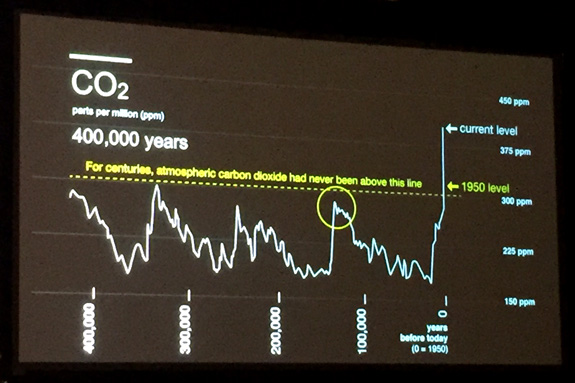There’s no better way to learn a new subject than to immerse yourself in it completely, right? And if you’re on your second week of the job, it makes sense for your employer to just throw you in headfirst.
Before I started at Interface, I thought I knew some things about climate change and sustainability. The 2017 Living Product Expo in Pittsburgh, hosted by the International Living Future Institute (ILFI), proved me very, very wrong.

“Hello from beautiful Pittsburgh!”
What’s nice about going to something of an “insider” conference is that everybody already gets it. People attend the Living Product Expo because they want to find practical, sustainable solutions to their problems. They’re talking about how to build better buildings. They’re introducing innovations in sustainable products and materials. They’re taking on ILFI’s Living Product Challenge or Living Building Challenge.
As I am not a designer, builder, manufacturer nor sustainability enthusiast, I attended the Living Product Expo to get an education in all of the above.
What I learned was eye opening. There are tons of organizations and companies working to make positive impacts on the environment and tackling sustainable solutions to global warming worldwide. Some were obvious; some were not. Let’s dive in, shall we?
Reversing global warming
Paul Hawken’s keynote gave plenty of reason reasons to be optimistic on the climate change front. And he laid out a new goal of working to reverse global warming completely. The Paris Climate Accord was a good first step, but aiming to simply reduce is not enough.
“When you believe something, you believe it into existence and it becomes your experience.”
Having a goal of reducing global warming implies complacency. It says that we’re okay with letting harmful pollution go unchecked if we can possibly offset it elsewhere. Therefore, we have to reverse global warming if we want to do any good for the earth and the people who live on it.
(For the record, Hawken’s Project Drawdown has compiled a list of scalable, sustainable solutions to global warming to look at and support if you’re interested.)
How chemicals affect human health
It’s crazy how many chemicals we are exposed to simply because of the materials that make up our built environment. And given that we spend the vast majority of our lives indoors, this is something that affects everyone.

A visualization of CO2 in the Earth’s atmosphere over time.
Several panels centered around how we measure our chemical exposure, how that affects our health, and what we can do about it. One of the major barriers to change? There have been no major environmental protection laws passed in 20 years. And, government regulation in general has slowed compared to science.
From an industry perspective, the compounding effect of chemical exposure and how to address it is a difficult but necessary discussion. Just look at the debate about PVC and whether it can be a responsible, sustainable material. It’s clear that industry needs to change, but it’s a slow and difficult process.
Making more noise about how built environments affect our individual health could spur change that much faster. And that’s not just at the manufacturer level, but also at the legislative level.
What can we do about it?
I’m not the person with all the answers—that much should be clear. And, my education in these topics is far from over. But one of the Living Product Expo’s recurring themes was the power of individual action to create change.
We as individuals have more power than we think. Beyond recycling more and driving less, we can make the biggest impact by leveraging our position as consumers. If we can’t get the government to pass stricter regulations, we have to give consumer feedback to the companies we buy products from. In a society where money talks, monetary support (or lack of) can really create change.
If consumers pushed back more on industry, it would force a perspective shift from simply focusing on profit to focusing on corporate responsibility. That impact would spread outward, adding to all the other countless efforts to find sustainable solutions to global warming and really do some good.
As I reflect back on my few days at the Living Product Expo and get immersed in life at Interface, I’ve started to change my own personal habits. It may be my small contribution, but it’s nice to be part of a company that’s tackling the tough questions and really making good on its mission to address global warming head on.
One response to “Sustainability for Beginners: Lessons Learned from 2017’s Living Product Expo”
Hello,
Trust this meets you well.
Firstly , thanks so much for your post. I am a Sustainability Enthusiast. I am green-horned in this field but believe it should be of great importance. I am interested in taking online courses that would broaden my horizon. kindly suggest . I look forward hearing from you. Thanks